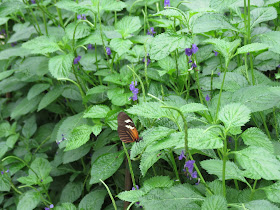Monday, November 30, 2015
Sunday, November 29, 2015
Johns' Tracks
On Thanksgiving down at the lighthouse, we noticed these large spots on the ground near the boat ramp. We paused to consider what might have left the marks.
Finally, we remembered that there had recently been two port-a-potties there.
I guess the grass isn't always greener.
Friday, November 27, 2015
Happy Heron Day!
Before our Thanksgiving dinner for two, B and I made a run down to the lighthouse. The weather was just perfect and there were a few others who had the same idea. Here is the dike and spill dam at the East River. We have had seven inches of rain here in November and the water was running.
The eagles were at their nest. The second was in an adjacent pine, but no sign of this year's young.
The eagles were at their nest. The second was in an adjacent pine, but no sign of this year's young.
The gators of all sizes and large turtles were out on the banks enjoying the warm sun with the cool breeze. These turtles were much larger than dinner plates.
The butterflies were seeking shelter out of the wind. We saw very few.
This great blue heron was keeping one leg warm up under its breast feathers.
"Just because my head is blue, doesn't mean I'm a turkey, you know. "
Monday, November 23, 2015
Tuesday, November 17, 2015
St. Marks Submarine
The tide was way out at St. Marks when I took this picture of the oyster/sand bar. B. commented that it looked like a submarine.
Monday, November 16, 2015
Sunday, November 15, 2015
Ibis and Mickey Mouse
The ibis are back at St. Marks, happily eating shrimp to keep them in the pink!
Check out Mickey photo-bombing below.
Saturday, November 14, 2015
Migrating Monarchs and Other Butterflies
We took the three-year-old grandson for the afternoon in October and bless his heart, when asked where he wanted to hike, he said, "St. Marks Lighthouse!" So we gathered up a picnic and went on an adventure.
Here's how he looked when we picked him up.
Here's how he looked when we picked him up.
We were not disappointed and saw lots of wildlife, including many butterflies:
Gulf Fritillaries
Skippers
And Monarchs.
Friday, November 13, 2015
Perfect Camou
I believe this to be a yellow warbler, perhaps an immature. It had found the perfect camouflage in some goldenrod.
Thursday, November 12, 2015
Newly-Found Old
I recently discovered a fairly large fossil in a place I have walked many times through the years. How I could have not seen it before is a mystery, but finding it is a gift. I believe it to be an ammonite fossil, because of its spiral shape. I read that ammonites are perhaps the most commonly known fossils, in part due to their longevity as a species. They lived in shallow waters from 240-65 million years ago. The last died at the same time as the dinosaurs became extinct. Some ammonite fossils are tiny, while others may be larger than platters.
Wednesday, November 11, 2015
Visited by the Candidates on Veterans Day
This morning at breakfast, I looked through the window and past the maple tree and there was a wild turkey walking in the cul-de-sac. And then there were four and, finally, six turkeys, all presumably hens.
I have heard the story that Benjamin Franklin had proposed that the turkey serve as our national bird, but Smithsonian reports that is a myth; but that he did write to his daughter that a turkey would be a better symbol than the eagle.
A turkey might be a better symbol now than an elephant or a donkey.
Monday, November 9, 2015
Mailbox Monday: Repurposed
My cousin has this former mailbox in her yard. She uses it to store hand tools that are used in the garden.
Saturday, November 7, 2015
Callaway's Butterfly Exhibit
You can't go to Callaway without going in the butterfly exhibit. It is a nice facility.
In August, they were featuring a certain species of butterfly, called a blue morpho. Though native to Central and South America, they were growing them from chrysalises, by the dozen. We watched a couple of butterflies emerge. We saw dozens of blue morphos released into the indoor gardens. Below is a blue morpho. When the wings are closed, almost no blue is visible.
The sign below tells the story of the top of the roof. It came from the home place in Pelham of Mrs. Callaway.
The entrance belies the total volume of the building.
In August, they were featuring a certain species of butterfly, called a blue morpho. Though native to Central and South America, they were growing them from chrysalises, by the dozen. We watched a couple of butterflies emerge. We saw dozens of blue morphos released into the indoor gardens. Below is a blue morpho. When the wings are closed, almost no blue is visible.
When they fly,the vibrant blue on the tops of the wings can be startling.
The blue is the result of microscopic scales that reflect blue light into our eyes, rather than pigment.
"Look here, guys! This is about us!"
Over-ripe bananas serve as feeders.
This philodendron was FULL of butterflies.
Other butterflies were also present in the exhibit.
This plywood puzzle-style sculpture is bigger than you might think.
Callaway, with all its struggles, is still worth the admission and proved to be a fun attraction for B and me on our anniversary.






































